How to use OAS generator in Front-end environment?
I am using OAS-generator in project recently. When deciding to use it, there were many things that required consideration and confirmation. And, I'm going to write about my experience using OAS-generator because it seems to have a lot of good things after using.
Perhaps those who are curious about what OAS-generator is, those who know but are worried about using it, and those who are already using it but are hesitant to use it well, I hope that you will learn good motifs and experiences by reading this article.
What this article says is as follows.
- What is the OAS-generator.
- The pros and cons of using OAS-generator.
- How to use OAS-generator.
- Configuration
- Custom Templates
- Optimization
- The experience to develop front-end using Rest API
- Can read the mustache Grammar(Optional)
- Even if you don't know, there's no problem reading this article. But, you want to use OAS-generator, you should know it.
OAS Generator, What is it?
Before to know OAS Generator, Let to know what is the OAS.
OAS? Open Api Specification
OAS is abbreviation of Open Api Specification.
The OpenAPI Specification (OAS) is a vendor neutral description format for HTTP-based remote APIs.
If you can see The document about OAS, OAS is said to have named a rule for writing documents that both machines and people can understand about HTTP-based APIs. For example, when you click that link as shown in the image below in the swagger document, it connects to the OAS document. The JSON or yaml files consisting of text are OAS(Open Api Specification).


OAS Generator
We know that OAS is json/yaml document of API. Then, what is the OAS Generator?
- OAS Generator is tool that generate Source code using OAS yaml file.
- In other words, It translates to this flow. API Swagger → OAS text file(.yaml) → Source Code(.ts).
- You can generate various output(Java, Kotlin, Typescript, etc.) using various Generator.
- In Web Front end ecosystem, I understand that typescript-axios or typescript-fetch is mainly used.
As will be described later, OAS results are automatically generated in the following ways and benefit from using these codes inside the project.(code sandbox)
// Auto generated codes
...
deletePet: async (petId: number, apiKey?: string, options: AxiosRequestConfig = {}): Promise<RequestArgs> => {
// verify required parameter 'petId' is not null or undefined
assertParamExists('deletePet', 'petId', petId)
const localVarPath = `/pet/{petId}`
.replace(`{${"petId"}}`, encodeURIComponent(String(petId)));
// use dummy base URL string because the URL constructor only accepts absolute URLs.
const localVarUrlObj = new URL(localVarPath, DUMMY_BASE_URL);
let baseOptions;
if (configuration) {
baseOptions = configuration.baseOptions;
}
const localVarRequestOptions = { method: 'DELETE', ...baseOptions, ...options};
const localVarHeaderParameter = {} as any;
const localVarQueryParameter = {} as any;
// authentication petstore_auth required
// oauth required
await setOAuthToObject(localVarHeaderParameter, "petstore_auth", ["write:pets", "read:pets"], configuration)
if (apiKey !== undefined && apiKey !== null) {
localVarHeaderParameter['api_key'] = String(apiKey);
}
setSearchParams(localVarUrlObj, localVarQueryParameter);
let headersFromBaseOptions = baseOptions && baseOptions.headers ? baseOptions.headers : {};
localVarRequestOptions.headers = {...localVarHeaderParameter, ...headersFromBaseOptions, ...options.headers};
return {
url: toPathString(localVarUrlObj),
options: localVarRequestOptions,
};
},
...
The above example are part of generated code using OAS generator. It generates codes that are filled path, method, headers and are set request and response about each api.
So, what's good?
The difference from conventional way
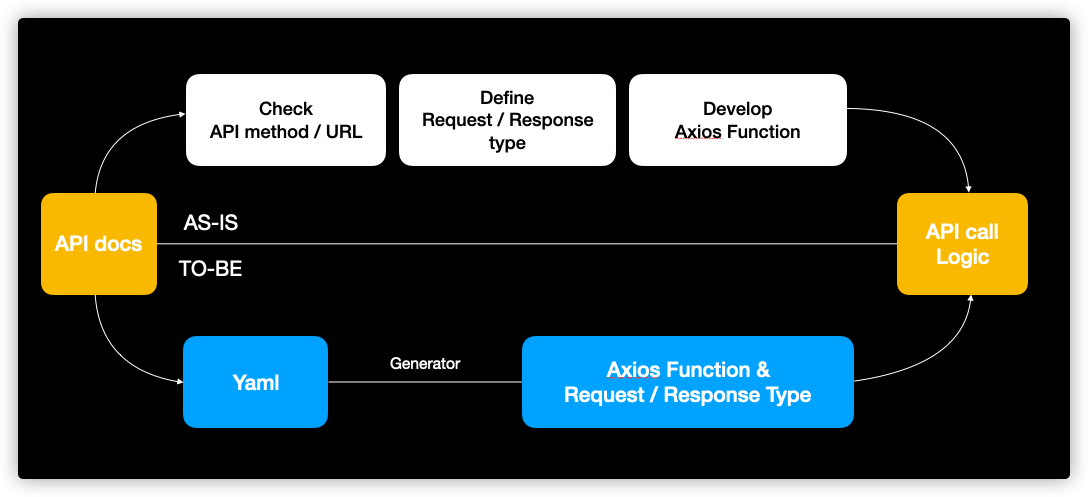
We link APIs while developing. If we don't use OAS generator, We will develop following above AS-IS flow. We see API documents and check URL and method, etc and define the type of Request and Response. Then, we create functions associated with axios and use API call logics. In this sequence, we can mistake to check the method incorrectly or can mistype during move the Request/Response type one by one. In addition, if API documents are updated, efforts are needed to recognize that the API has been updated and to follow the changes and modify them.
On the other hand, If we use OAS generator, we will develop following above TO-BE flow. First, we bring yaml file(OAS spec) in the API docs. Generally yaml file is auto generated with API docs. Next, we generate Axios functions using yaml file. The type of request and response are also generated same time. It is used for API call logic as it is.
Even if API document is updated, running the OAS generator again shows the difference from the previous API as git diff, and it is easy to see which part has changed and which part needs to be checked.
In other words, the advantage is to reduce repetitive work and minimize human errors by reducing the parts that developers write themselves.
It is just good?
I talked about advantages, but of course, there are points~~(disadvantages)~~ to pay attention to.
1. Yaml files should be able to be extracted from API documents.
I think there are many ways to manage API documents by company and project. The example above is based on the premise of using a swagger. In various other ways, API documents may be shared or development may be carried out without API documents. If API documents are impossible to generate a yaml file, the OAS generate may not be a valid alternative
2. API documents must be accurate.
Since the OAS Generator generates code based on API documents, the auto-generated code becomes inaccurate if the API documents are not accurate. For examples, If fields of request parameter are all set optional, all auto generated type are set optional. Then, we can lose advantage of type check because optional is overused. In addition, if the actual serve has been updated but the API document has not been updated, the OAS generator rather complicates the project. API documents should be as accurate as generating code through API documents.
3. Duplicated code, The increase bundle size.
OAS Generator generate code using template and API documents. Therefore, a specific pattern of template is repeated, which naturally creates duplicated code. This leads to a definite increase in bundle size. Even if project development becomes easier and maintenance improves, it will inevitably be reluctant to use it if it adversely affects performance. At the env of this article, we will discuss optimization later, but it is necessary to compare bundle sizes before and after applying OAS Generator.
4. Initial configuration code and configuration maintenance
What I felt when I applied the OAS Generator was that the initial configuration value was complicated and the learning curve was higher than I expected, and I customized several settings and templates for the project. The fact that there is a customization part means that there are more things to know about future project maintenances, so several steps are needed, such as documentation or sufficient sharing within the team.
In particular, as described in No. 3, if optimization was conducted for project performance, it would be necessary to share the history of this.
Next
So far, I think we have outlined the advantages and disadvantages of using the OAS Generator. Now, let's take some time to figure out hot to use it.
Usage of OAS Generator
The introduction was long. Now I will explain how to use the OAS Generator. Except for Custom Template, most of the uses are to modify settings using the CLI.
In the code sandbox, You can check the code shown in the example below.
1. Get the yaml file.
OAS Generator is a way of automatically generating code using a local yaml file. In addition, since it is 1:1 correspondence, one code is generated from one yaml file. If the API document has multiple yaml files, the flow described now must be executed several times.
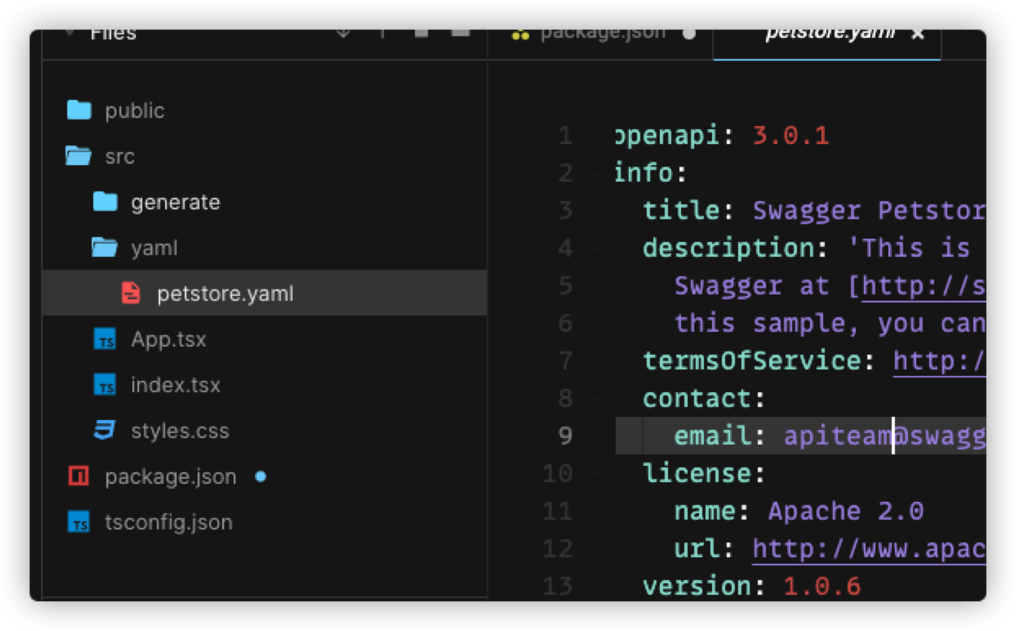 In this example, I get the
In this example, I get the petstore.yaml file.
2. generate code using open-api-generator-cli.
Using open-api-generator-cli, specify template, input, and ouput path to generate code.
npm install @openapitools/openapi-generator-cli
openapi-generator-cli generate -g typescript-axios -i ./src/yaml/petstore.yaml -o ./src/generate
Like above, add dependency of openapi-generator-cli
and run openapi-generator-cli
-gis the option to set generator, in this case I usedtypescript-axios.-imeans input. Set yaml file path used generate.-ois output path. Set where the code will be generated.
If you run above code, code is generated in the src/generated directory.
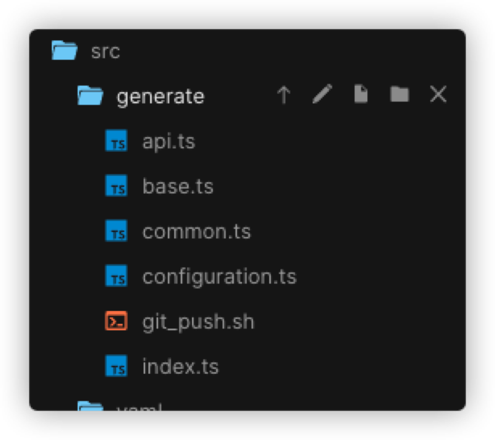
Inside api.ts, an axios util function containing the api request and response types and the type are generated together.
3. Use generated code.
Now, you can use the generated code.

Since it is a code generated based on the typescript, the type check of request and response proceeds successfully.
When referring to the data object, it informs the internal type of Pet, id , name, category, etc.
Next
A brief summary of how to use it is as follows.
Get the
yamlfile -> Run OAS generator cli -> Use generated code
However, as with all tools, it is necessary to customize it for real projects. In the official documents, it serves several customize guides. What I used was customizing the template. The customization method to be described in the article is mainly about how to customize the template.
OAS Generator Config
There are also some OAS generator settings. Mainly CLI options and openapitools.json is set.
The setting of OAS Generator - CLI
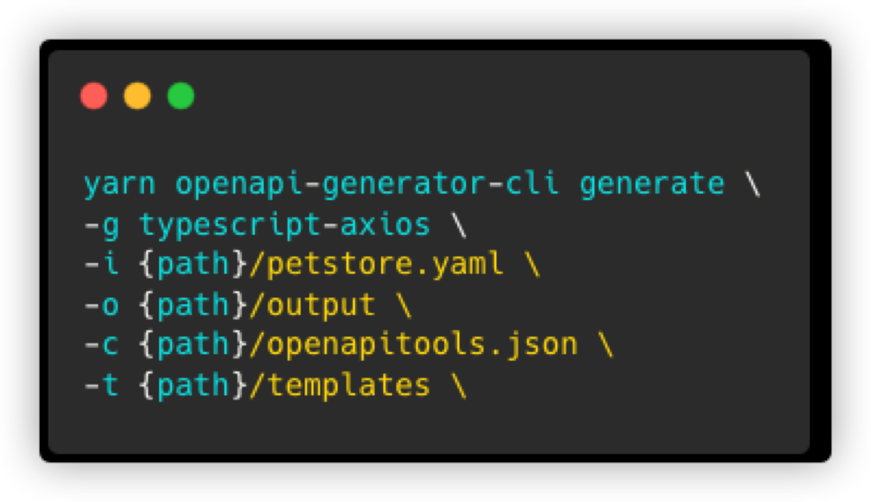
-g: The option to setgenerator. In this case, usetypescript-axios.-i: The target yaml file path.-o: The generated output file path.-c: The setting file of generator.-t: The custom template file path
The CLI use the generate command,and there are five main options.
The -t option is used to designate custom templates and will be discussed in following articles.
The setting of OAS Generator - Config file
{
"$schema": "node_modules/@openapitools/openapi-generator-cli/config.schema.json",
"spaces": 2,
"generator-cli": {
"version": "5.3.1"
},
"supportsES6": true,
"withSeparateModelsAndApi": true,
"apiPackage": "api",
"modelPackage": "models",
"enumPropertyNaming": "original",
"enumNameSuffix": "",
"useSingleRequestParameter": false
}
This configuration file is a file that enters -c in the CLI option, and mainly contains the generator configuration values.
In this example, we use typescript-axios and see here for more options
OAS Generator Template
It would be good to use the default settings, but you should need to edit setting for fitting actual project.
Official documents has customization guide part.
Retrieving Templates was the most directly helpful item.
In other words, the template registered by default is imported and modified according to the project.
The way following this article is largely related to the template entering the -t option described in the CLI.
When do you use Custom Template?
This is method to use when you want to modifiy and use a template that uses the default setting.
For example, if you want to add a suffix such as Axios after the addPet or deletePet method names as follows,
you can modify the template.
- Before using custom template
- After using custom template
export class PetApi extends BaseAPI {
public addPet(body: Pet, options?: AxiosRequestConfig) {
return PetApiFp(this.configuration).addPet(body, options).then((request) => request(this.axios, this.basePath));
}
public deletePet(petId: number, apiKey?: string, options?: AxiosRequestConfig) {
return PetApiFp(this.configuration).deletePet(petId, apiKey, options).then((request) => request(this.axios, this.basePath));
}
...
}
export class PetApi extends BaseAPI {
public addPetAxios(body: Pet, options?: AxiosRequestConfig) {
return PetApiFp(this.configuration).addPet(body, options).then((request) => request(this.axios, this.basePath));
}
public deletePetAxios(petId: number, apiKey?: string, options?: AxiosRequestConfig) {
return PetApiFp(this.configuration).deletePet(petId, apiKey, options).then((request) => request(this.axios, this.basePath));
}
...
}
Of course, it is only a simple examples, and it is possible to add parameters or customize other function.
Flow of Custom Template
 The previous flow is the flow that generated the Axios function in the yaml file as above.
If you add a Custom Template here, the flow changes as follows.
The previous flow is the flow that generated the Axios function in the yaml file as above.
If you add a Custom Template here, the flow changes as follows.
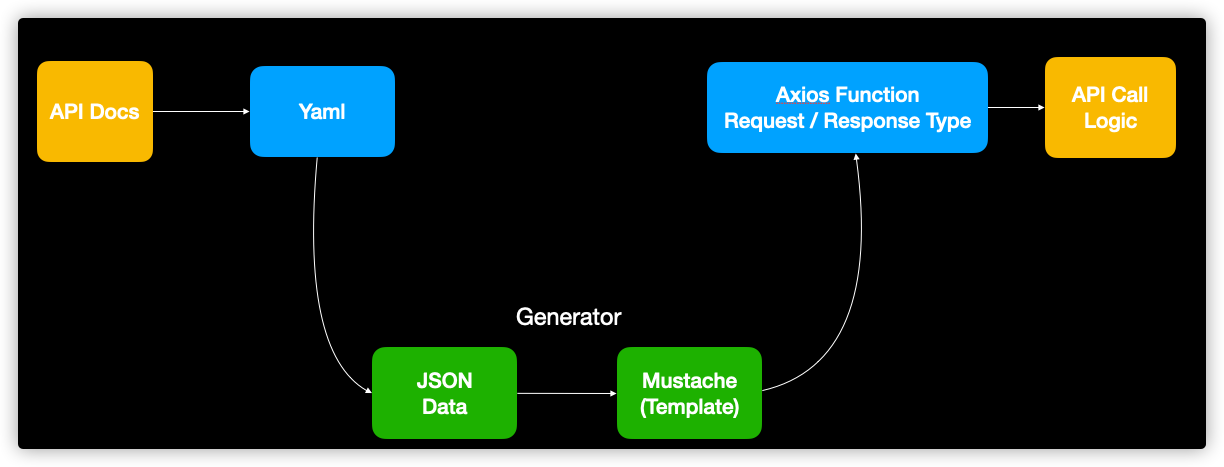 The OAS Generator extracts JSON data from the yaml file.
This JSON data contains a path, a method, and various information about the API.
These JSON data are injected into the Template and generated as an Axios function.
The OAS Generator extracts JSON data from the yaml file.
This JSON data contains a path, a method, and various information about the API.
These JSON data are injected into the Template and generated as an Axios function.
The custom to be following here is about hot to change the template.
Get the Template files
openapi-generator-cli author template -g typescript-axios -o ./mustaches
openapi-generator has author scripts except generate script.
When author script is run, the following template is created.
/mustaches
ㄴ api.mustache
ㄴ apiinner.mustache
ㄴ baseApi.mustache
ㄴ common.mustache
ㄴ configuration.mustache
...
This is a mustache template used to run OAS Generator with typescript-axios.
If you don't give the -t option in the CLI, by default, use the corresponding mustache template located remotely to generate proceed.
In other word, if you modify only the mustache template that you want to modify and delete the remaining unmodified templates, you can reduce the management area by following the remote default settings.
Mustache Template
We can now modify mustache imported to local. This requires a brief understanding of mustache grammar, so if you are not familiar with mustache, check this article. As alone as you can only read variables, Sections, Lists, and Inverted Sections, since you are modifying an already completed template.
For example, if you want to attache a suffix called Axios to the classname created as the example introduced above, you can modify it as follows.
- Before Custom Template
- After Custom Template
{{^useSingleRequestParameter}}
public {{nickname}}({{#allParams}}{{paramName}}{{^required}}?{{/required}}: {{{dataType}}}, {{/allParams}}options?: AxiosRequestConfig) {
return {{classname}}Fp(this.configuration).{{nickname}}({{#allParams}}{{paramName}}, {{/allParams}}options).then((request) => request(this.axios, this.basePath));
}
{{/useSingleRequestParameter}}
{{^useSingleRequestParameter}}
public {{nickname}}Axios({{#allParams}}{{paramName}}{{^required}}?{{/required}}: {{{dataType}}}, {{/allParams}}options?: AxiosRequestConfig) {
return {{classname}}Fp(this.configuration).{{nickname}}({{#allParams}}{{paramName}}, {{/allParams}}options).then((request) => request(this.axios, this.basePath));
}
{{/useSingleRequestParameter}}
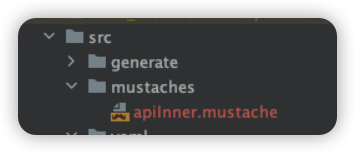
Then, leave only the modified template file and delete the remaining unmodified template files. Files that are not locally generated are automatically generated using remote templates.
Check JSON Data
Now, I have imported the template locally, and I know that I can modify the template.
However, the question still arises is that you do not know what value is included in the variable nickname or classname in the template image above.
Now, it's time to check out the JSON Data, which went over from Flow of Custom Template.
To use appropriate data for the template, you need to find out what data is extracted from the yaml file and in what format it is injected into the template.
openapi-generator-cli generate \
-g typescript-axios \
-i ./src/yaml/petstore.yaml \
-o ./src/generate \
--global-property=debugModels,debugOperations \
> output.txt
There are many ways to do this, but if you give the CLI option --global-property=debugModels,debugOperations,
What data is extracted from the yaml file is output to the console. Therefore, a method of checking with a text file through > output.txt was used.
The extracted contents of operations follow the image format as shown below, and operators that can be seen in the template,
It can be seen that data such as classnames, path, and httpMethod are included and used in the mustache template.
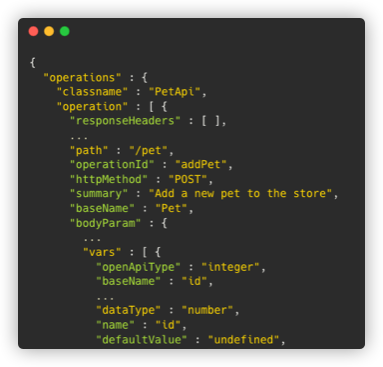
The example of Custom Template
As an example of using a Custom Template, I brought up the use of "axios" in the suffix. However, it is only a simple example to help understanding, and it can be applied in various ways in actual use. I brought the custom example used in the actual project.
Since we can't see the entire code and following example is part of generated code, it may not be clearly understood how it is implemented. However, I hope you can see the following examples as a possibility and get the idea of using Custom Template.
Convert from Enum Type to Union Type
typescript-axios template is using Enum type of typescript when define type. But I don't like to use Enum type.
So, I tried to convert to Union type.
- Before Custom Template
- After Custom Template
{{#vars}}
{{#isEnum}}
export enum {{enumName}} {
{{#allowableValues}}
{{#enumVars}}
{{{name}}} = {{{value}}}{{^-last}},{{/-last}}
{{/enumVars}}
{{/allowableValues}}
}
{{/isEnum}}
{{/vars}}
{{#vars}}
{{#isEnum}}
export type {{enumName}} =
{{#allowableValues}}
{{#enumVars}}
{{{value}}} {{^-last}}|{{/-last}}
{{/enumVars}}
{{/allowableValues}}
{{/isEnum}}
{{/vars}}
- Before Generated Code
- After Generated Code
export enum PetStatusEnum {
Available = 'available',
Pending = 'pending',
Sold = 'sold',
}
export type PetStatusEnum =
'available' |
'pending' |
'sold'
Convert to Snake case variable naming rule to Camel case variable naming rule
The server used the snake case for the variable naming rule, and the client used the camel case as the variable naming rule. Therefore, there were difficulties caused by different variable names used in the OAS document and the actual generated code. Use the lambdas provided by the OAS generator. Snake case naming variables were collectively converted into camel case naming variables.
- Before Custom Template
- After Custom Template
{{#vars}}
'{{baseName}}'{{^required}}?{{/required}}: {{#isEnum}}{{{datatypeWithEnum}}}{{/isEnum}}{{^isEnum}}{{{dataType}}}{{#isNullable}} | null{{/isNullable}}{{/isEnum}};
{{/vars}}
{{#vars}}
'{{#lambda.camelcase}}{{baseName}}{{/lambda.camelcase}}'{{^required}}?{{/required}}: {{#isEnum}}{{{datatypeWithEnum}}}{{/isEnum}}{{^isEnum}}{{{dataType}}}{{#isNullable}} | null{{/isNullable}}{{/isEnum}};
{{/vars}}
- Before Generated Code
- After Generated Code
export interface User {
id: number;
username: string;
first_name: string;
last_name: string;
email: string;
password: string;
phone: string;
user_status: number;
}
export interface User {
id: number;
username: string;
firstName: string;
lastName: string;
email: string;
password: string;
phone: string;
userStatus: number;
}
Edit util function in template
I extracted the utility function that commonly used logic in typescript-axios and generate code.
For example, serialize did not need to be used in our project, and serialize logic was excluded by modifying it as follows.
- Before Custom Template
- After Custom Template
export const serializeDataIfNeeded = function (value: any, requestOptions: any, configuration?: Configuration) {
const nonString = typeof value !== 'string';
const needsSerialization = nonString && configuration && configuration.isJsonMime
? configuration.isJsonMime(requestOptions.headers['Content-Type'])
: nonString;
return needsSerialization
? JSON.stringify(value !== undefined ? value : {})
: (value || "");
}
export const serializeDataIfNeeded = function (value: any, requestOptions: any, configuration?: Configuration) {
const nonString = typeof value !== 'string';
const needsSerialization = false;
return needsSerialization
? JSON.stringify(value !== undefined ? value : {})
: (value || "");
}
- Before Generated Code
- After Generated Code
export const serializeDataIfNeeded = function (value: any, requestOptions: any, configuration?: Configuration) {
const nonString = typeof value !== 'string';
const needsSerialization = nonString && configuration && configuration.isJsonMime
? configuration.isJsonMime(requestOptions.headers['Content-Type'])
: nonString;
return needsSerialization
? JSON.stringify(value !== undefined ? value : {})
: (value || "");
}
export const serializeDataIfNeeded = function (value: any, requestOptions: any, configuration?: Configuration) {
const nonString = typeof value !== 'string';
const needsSerialization = false;
return needsSerialization
? JSON.stringify(value !== undefined ? value : {})
: (value || "");
}
The story of optimization
We understand pros and cons of OAS Generator, and we know that usage and method to customize. If so, the essential story is optimization. A good tool has been applied, and it reduces hassle and improves development stability, but it can't be easily use if it adversely effects performance.
OAS Generator is largely influenced by bundle size. When using the OAS Generator, the amount of code increases, which leads to an increase in bundle size. Then user sees the web page late. Therefore, it must be checked.
When I applied it to the project, there were about 10 yarm files in the project, and each yaml file had a single feature. As this was gradually applied one by one for each function, the generated code had the following capacity.
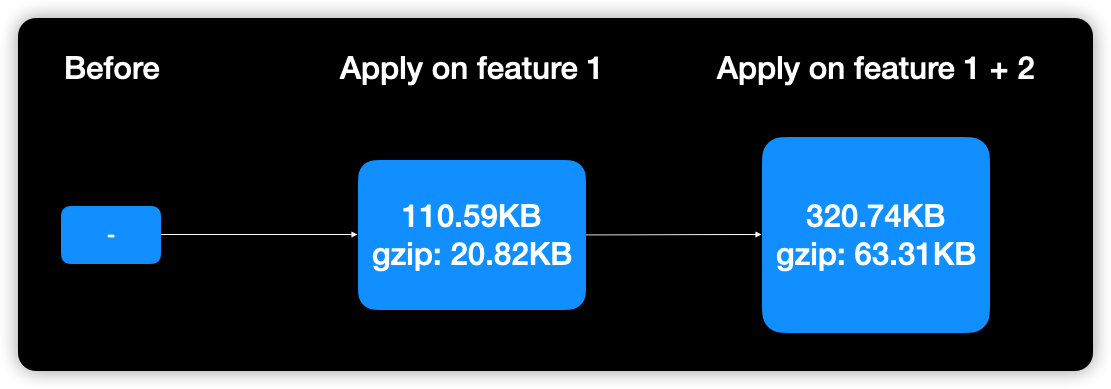
When one feature was applied, the generated code had a size of 20KB based on gzip, and 63KB when two features were applied. Considering that the total gzip size of the project at that time was around 560KB, it was a fatal condition that increased the capacity by 11% of the total. Even since it was not applied to all features, it could be expected that the size would increase arithmetically in the future.
Attempt 1: Reduce total code size.
The first attempt is to reduce the amount of code. generate, due to the nature of automatic code generation, a single line of templates influenced dozens of generated codes. This led to an increase in the overall code volume, bundle size. Therefore, the required variable's guard logic and the header settings that are not used in our project were removed. In addition, for the same common code repeatedly generated by the OAS Generator, methods such as moving it inside the project and using it as a common function were used.
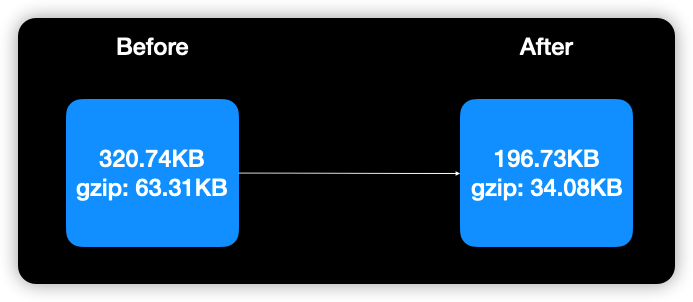
This solution reduced the size from 63KB to 34KB to about 53%. The code that you don't use for each project is different, so the degree of reduction is different. Please note that removing unnecessary logic from the template was also effective in reducing the bundle size.
Attempt 2: Tree shaking
The amount of code has been reduced enough. However, there was still a way to further reduce the bundle size. It's tree shaking.
If you use all the APIs in the API document, you don't have to consider tree shaking, but our project didn't Therefore, if unused API codes are included in the bundle, it means that unnecessary codes are included, which can be seen as an improvement.
This may vary depending on the bundler and usage environment, but the project I experienced was building using webpack v5, and webpack v5 was using variable units instead of file units about tree shaking, so I thought tree shaking was working well, but it wasn't. This is because APIs were not created with each variable, but were created in the form of a method under one object, class.
In webpack v5, each variable supports tree shaking, and the unused variable is excluded from the bundle, but the key / value present in the object is not.
Therefore, it was changed from a structure in which all API call functions were contained in one existing object to a structure in which each API call function was separated into each variable.
This change was also carried out by customizing the template.
- Before Generated Code
- After Generated Code
export const PetStoreApi {
getPet: () => { ... },
postPet: () => { ... },
}
export const petStoreGetPet = () => { ... }
export const petStorePostPet = () => { ... }
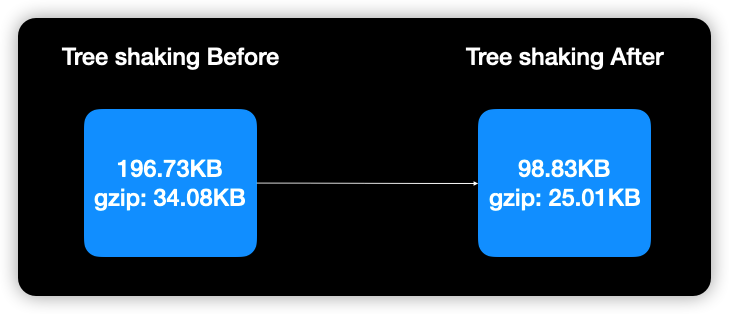
After the tree shaking, the size decreased from 34KB to 25KB. Although it has not improved significantly in terms of ratio, it was possible to guarantee that only the necessary codes were included in future implementations.
Result
The bundle-size optimization caused by OAS ends here.
If you look at the final result, the OAS generated code takes up 25KB, which seems to be quite a lot.
Comparing the entire project bundle-size was as follows.
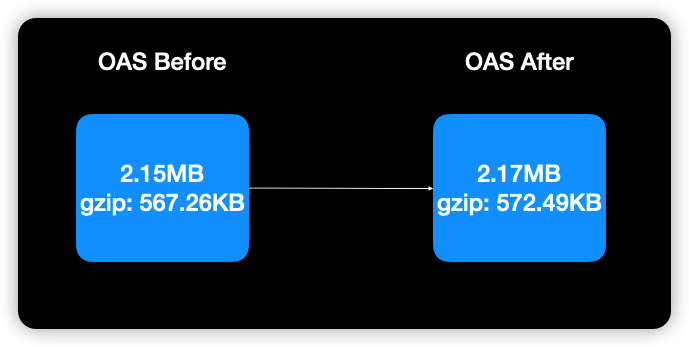
When OAS was not applied at all, the project, which was about 567KB, showed a slight increase of about 572KB after OAS was applied. Therefore, it was concluded that even if OAS is applied, size is not a big problem if appropriate optimization and analysis processes are performed.
Recap
- The OAS Generator is a tool for converting API documents into development code(.ts).
- This reduces human errors and reduces resources to work manually, such as creating types.
- Code is auto generated like this flow.
yaml file -> oas-generator-cli -> generated code. - The OAS Generator can customize and use the code template for the project.
- If you don't optimize the OAS generator, It can cause a lot of lose to the bundle size, but if you do so, you won't have to worry.
